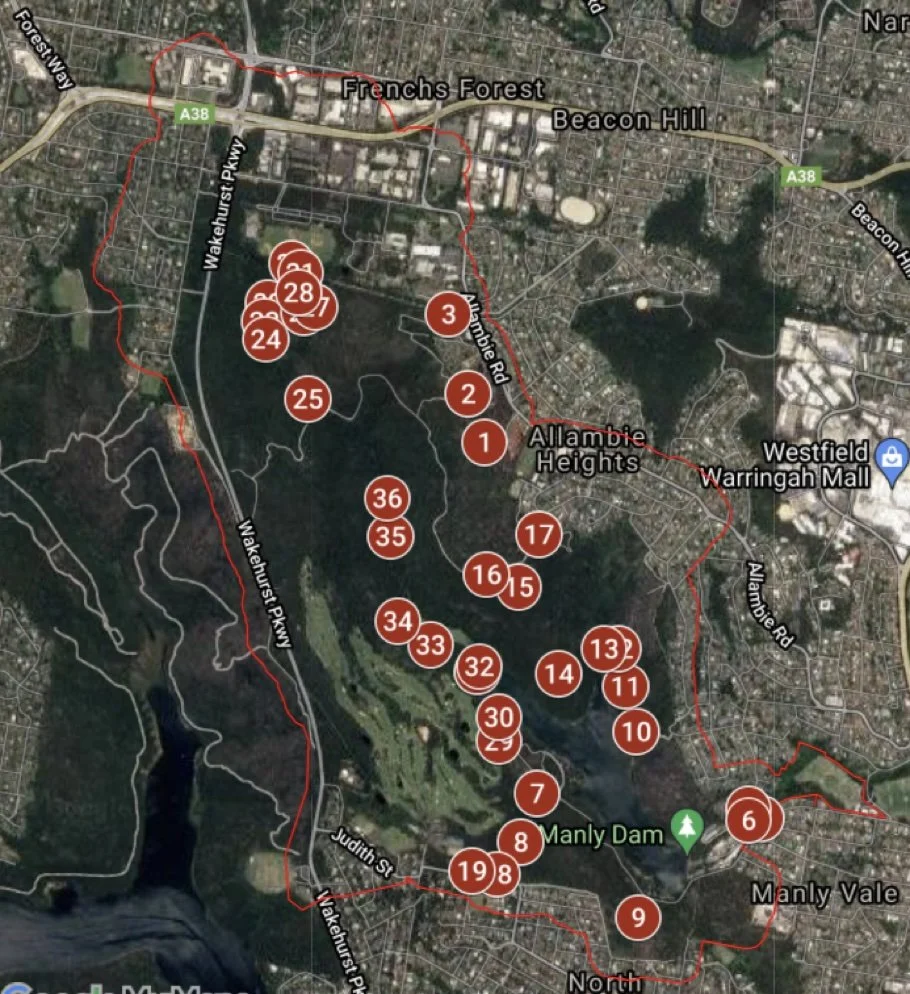Manly Dam’s Biodiversity
Biodiversity is indicated by the numbers of different species of plant and animal occurring in an environment. Each species has an important role to play which creates a healthier ecosystem. For e.g. Echidnas aerate the soil by digging, Blue-banded bees pollinate native plants, eucalyptus leaves provide food for possums and so forth.
Australia is considered one of the planet’s megadiverse countries with many endemic animals. Yet we have the worst record in the world for mammal extinction - 34. Australia’s plants aren’t faring any better. Currently 1,385 species of plants are listed as threatened under the Environmental Protection and Biodiversity Conservation Act (EPBC).
“Until we grapple with the ongoing problem of habitat destruction, and repair the damage done, the fate of Australia’s threatened wildlife will remain dire.”
Resources from the Biodiversity survey: Reports & Maps
The Manly Dam Biodiversity Project is thus an attempt to document the species that are still thriving in this area and shine a spotlight on the amazing biodiversity it harbours.
As part of this project various ecologists have been involved in creating reports & mapping the region, below is a snapshot of those resources.
Advice from Experts: Management Actions
-

Dr Bradley Law, Principal Research Scientist, Forest Science Unit - NSW DPI
The greatest threat to bird & mammal diversity is the loss of habitat through urban encroachment and decreased connectivity from changes to local infrastructure. Ground mammals in particular are vulnerable to decreases in connectivity due to their limited dispersal abilities.
Management of feral animals like black rats, foxes and cats should be put in place as well as plans for protection of hollow trees, which are currently rare in the reserve. Techniques for creating artificial hollows in strategic locations could also be considered. Sensitive fire management in mosaics and avoiding any further clearing of surrounding bushland would also be high priority.
-

Dr. Arthur White, Environmentalist & Herpetologist
The dilemma for land managers of bushland is to balance the competing demands of bushland reserves for passive recreation or physical activity. Decisions to remove native bushland to create lawns, picnic areas, viewing platforms, bike tracks or other infrastructure result in a change in the balance of habitats available for wildlife. Every time habitats are changed, some native species are disadvantaged.
Many native animals are unable to hunt effectively if there is ongoing movement around them (such as bush walking, mountain biking) . This movement not only startles the prey (which may fly off or run away) but forces the predator to consider the source of movement (is this threat? Disturbance reduces feeding opportunities (as well as mating opportunities) and can be the main reason for species decline in urban reserves.
Walking tracks, roads or other structures should not be located close to sensitive habitat areas.
“It is now widely recognized that climate change and biodiversity are interconnected. Biodiversity is affected by climate change, with negative consequences for human well-being, but biodiversity, through the ecosystem services it supports, also makes an important contribution to both climate-change mitigation and adaptation. Consequently, conserving and sustainably managing biodiversity is critical to addressing climate change”
Ecological Photo Monitoring
By Vicky Heaton, Leicia Petersen and Nick Skelton
Very little is known about how the ecological communities in Sydney change over time. The vegetation types change between seasons and over the longer term due to fire.
The initial objective was to provide a baseline data set and 4 seasons of ecosystem (vegetation and habitat) visual monitoring across the Manly Dam catchment. The data set will enable future monitoring to allow long term assessment of biological temporal and spatial variability.
Thirty six permanent photo-monitoring sites were established across Manly Dam catchment. The location of each point was recorded using a Global Positioning System and a photograph looking down at the ground at the photo point position. A photo was taken in each of the primary compass directions from a standing position using a smart phone.
The photos were taken in spring 2020, summer2020/2021, autumn 2021 and winter 2021. Considerations were made to include a variety of vegetation types and other factors such as known bush regeneration sites and weed infestations, high foot traffic areas and points of natural beauty such as waterfalls within the park.
The report can be found here.








